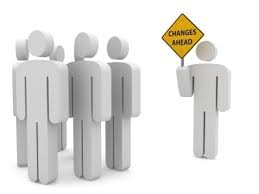 In a post from a few years ago titled Why Corporate Change is Difficult, But Possible, I described the obstacles to and steps needed to produce positive and long-lasting change in both individuals and companies. This concern continues to be at the forefront of business leaders’ minds because the corporate world is in a constant state of flux. These changes are driven by ever-evolving advancements in technology and globalization of just about every aspect of business including finance, research and development, manufacturing, and sales. The bottom line is that unless people and the companies they work for continue to adapt to these changes, they will suffer the same fate as dinosaurs.
In a post from a few years ago titled Why Corporate Change is Difficult, But Possible, I described the obstacles to and steps needed to produce positive and long-lasting change in both individuals and companies. This concern continues to be at the forefront of business leaders’ minds because the corporate world is in a constant state of flux. These changes are driven by ever-evolving advancements in technology and globalization of just about every aspect of business including finance, research and development, manufacturing, and sales. The bottom line is that unless people and the companies they work for continue to adapt to these changes, they will suffer the same fate as dinosaurs.
In general, people don’t like change. During primitive times, change was perceived as a threat to survival which triggered our ‘fight or flight’ response. Though fighting or fleeing increased the chances of survival for cavepeople, neither are very effective for business people in the 21st century.
Unfortunately, though we like to think that we have evolved far beyond our ancestors, the reality is that we are still quite primitives in some basic ways including our response to threats to our survival. In fact, that same reaction still occurs in us when presented with a perceived threat at work. So, our instinctive reaction to workplace change is to fight or run away, neither of which usually bodes well for the success of that change or the mental and physical health of those involved in that change.
I’ve returned to this topic because these three meta-stages of change, and the potential threat reaction, can be made easier if the individuals who are both responsible for and recipients of the change can understand and prepare for the individual and organizational disruption that are likely to occur.
The more participants in change can identify, understand, anticipate, and prepare for the coming wave of change, the better they will be able to buy into, adapt, and benefit from the changes that lie ahead. In other words, the less likely they are to fight the changes or flee from them.
As a consequence, before a program of change is implemented, significant effort must be directed at removing the threat from the proposed change. The apparent dangers of the change can be mitigated with a few proactive strategies.
To best prepare for change, I want to describe four “from-to” shifts that you and your company will need to embrace to gain the most value from the changes that will occur.
From Something Different to Status Quo
Create a long runway between the announcement of the changes and the implementation of those changes. As I just described, change is discomforting, but, with time, it can becomes more comfortable. So, leave plenty of time for people to wrap their comfort zone around the changes.
From Threat to Challenge
Actively shape perceptions about the changes. If you let workers decide about whether changes are good or bad, the changes are likely doomed to fail. Because their first reactions will be one of threat, their initial perceptions will be negative. Once a negative attitude begins to develop around change, it will spread like wildfire and will be nearly impossible to douse. You have to get out ahead of the this defensive reaction and frame the changes in the most positive ways with a particular focus on how it will benefit not only the company, but also the people who work there. This ‘positive management’ of the change will lessen the threat associated with the changes, thus reducing or eliminating the threat response. Instead, with a focus on the upsides of the changes, people will be receptive to them.
From Unknown to Known
Educate people about the changes. That which is unknown and unfamiliar is naturally uncomfortable and threatening. The result will be more fight or flight. But, the more they can learn about the changes, the less catastrophizing and hysteria will take place. In fact, with good information, the changes can morph from a threat to avoid into an opportunity and a challenge to pursue.
From Unpredictable and Uncontrollable to Predictable and Controllable
Empower people around the changes. A lack of predictability and control is one of the most powerful sources of threat and stress to people. When you actively engage people in the change process, from vision to strategy to implementation, you give them the power to predict what lies ahead for them and you give them a sense of control over how those changes will impact them. And, in doing so, you instill in them a sense of ownership of the changes, thereby ensuring buy in every step of the way.
In sum, few people like change, but change is inevitable. A company’s best chance of fully implementing the necessary changes and having their workforce align behind the changes is to give them time to assimilate the idea of change, shape their perceptions of the change, educate about the change, and, finally, empower them around the change. If you approach change in this way, you increase the likelihood that the changes will benefit both the company and those it employs.
Note: Due to an overly busy schedule, I will be suspending Prime Business Alert! until further notice. Please be sure to sign up for my sports and family newsletters.






